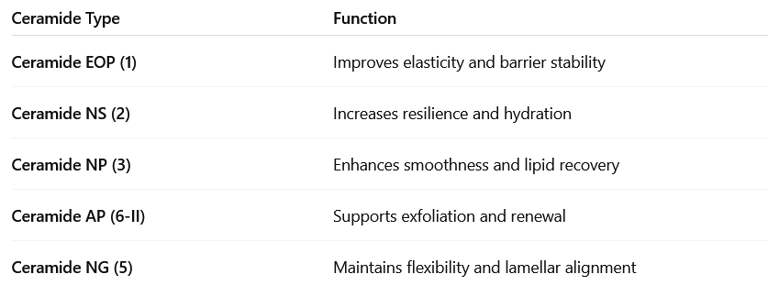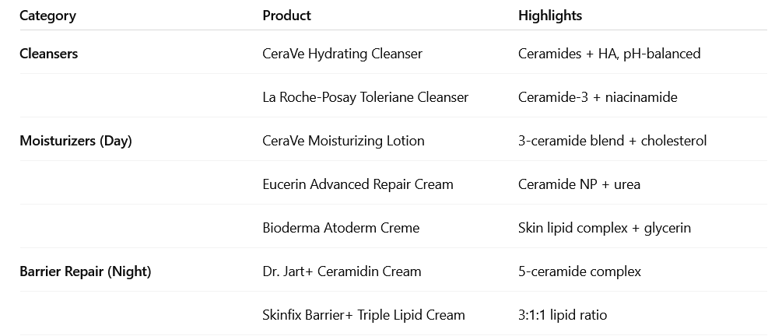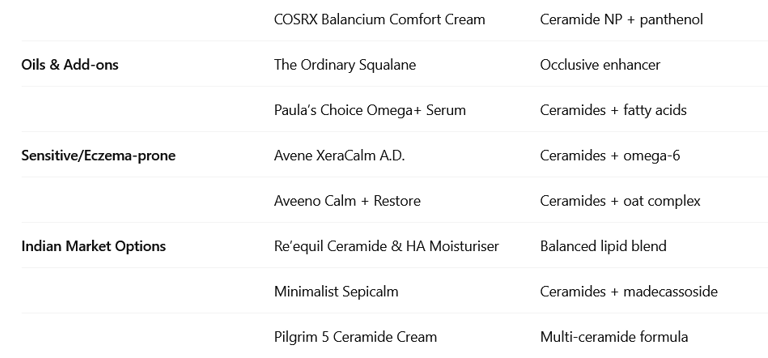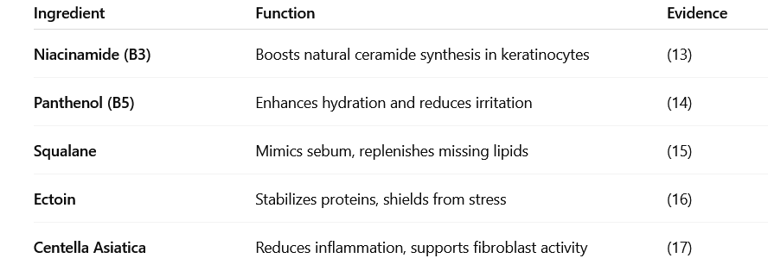
Ceramides - Everything You Need to know
Note: The content provided by Cordeo is for informational and educational purposes only and does not constitute medical advice, diagnosis or treatment. Always consult a qualified health provider for advice regarding your specific medical condition. [See Full Disclaimer]
If your skin barrier had a language, it would speak ceramides.
These naturally occurring lipids (fats) make up nearly half of your skin’s outermost layer, quietly keeping it hydrated, smooth, and resilient. Yet most people only start paying attention to them when their skin begins to sting, flake, or feel like parchment.
Ceramides aren’t just another skincare buzzword — they’re fundamental biology. Without them, even the most potent serums or actives can’t perform optimally. In this post, we’ll unpack what ceramides really are, why they matter medically, and how you can restore them with science (not hype).
What Are Ceramides?
Ceramides are sphingolipid molecules naturally found in the stratum corneum — the outermost layer of your epidermis.
They form part of the lipid matrix that cements your skin cells (corneocytes) together, often described as the “bricks and mortar” model of the barrier (1).
In healthy skin, ceramides account for 40–50% of total lipids. Along with cholesterol and free fatty acids, they build a tightly organized lamellar structure that prevents transepidermal water loss (TEWL) and keeps out allergens and microbes (2,3).
Without this lipid “mortar,” the bricks fall apart — leading to irritation, dehydration, and sensitivity.
Why Ceramides Matter
Every skin condition that involves dryness or inflammation — from atopic dermatitis (AD) to rosacea and post-procedure sensitivity — is associated with ceramide depletion (4,5).
When Ceramides Are Low:
Water evaporates more rapidly (↑ TEWL).
Irritants and microbes penetrate easily.
The immune system becomes overactive, producing inflammation (6).
Skin loses its elasticity and tolerance to actives.
Ceramide-rich skin, on the other hand, is calm, hydrated, and flexible — its barrier functions as nature intended.
The Lipid Trinity: Ceramides, Cholesterol & Free Fatty Acids
Your barrier’s strength depends not just on ceramides alone, but on their balance with other lipids.
The optimal physiological ratio for barrier repair is approximately 3:1:1 (Ceramides:Cholesterol:Free Fatty Acids) (7).
When any component is missing, the barrier lamellae can’t organize correctly. That’s why barrier-repair moisturizers using this “golden ratio” consistently outperform basic emollients in both clinical and consumer studies (8).


Types of Ceramides You’ll Find in Skincare
There are at least nine naturally occurring ceramide subclasses in human skin, labeled Ceramide 1–9 (9). Cosmetic chemists replicate these with identical or analog molecules like Ceramide NP, AP, EOP, NS, etc.
Formulas with multiple ceramides better replicate your natural lipid matrix than those with a single type (10).


When Should Ceramides Be Used?
Ceramides are most effective when your barrier is compromised — but beneficial even for maintenance.
Use Ceramides When:
After acid or retinol irritation
→ To reduce stinging and rebuild lipid balance.During eczema or dryness flare-ups
→ To restore lost NMF and prevent TEWL.After dermatologic treatments (e.g., peels, microneedling, lasers)
→ To accelerate recovery and reduce erythema.During weather transitions or flights
→ To counteract dry air and low humidity.When skin feels tight, flaky, or itchy
→ To buffer inflammation and restore comfort.
Ceramides can be safely used daily, AM and PM, and layered with actives. For sensitive or post-inflammatory skin, they should form the base of your repair routine.
How to Use Ceramides Effectively
Cleanse gently: Use pH-balanced, sulfate-free cleansers to avoid stripping natural lipids (11).
Apply to slightly damp skin: Traps moisture more effectively.
Layer correctly: Actives → Serums → Ceramide moisturizer → (Optional) Occlusive oil or balm.
Be patient: Barrier recovery takes 2–6 weeks of consistent use (12).
Top International Ceramide-Infused Products (Dermatologist-Approved)




Clinical Insight: How Fast Do Ceramides Work?
Studies show topical ceramide supplementation can normalize TEWL and lipid organization within 2–6 weeks (12).
Combination therapies using niacinamide and ceramides further accelerate recovery by enhancing endogenous ceramide synthesis (13).
In atopic dermatitis and irritant contact dermatitis, barrier repair formulas significantly reduced inflammation, erythema, and sensitivity thresholds compared to emollient alone (18).
Common Myths About Ceramides
Myth 1: Ceramides make oily skin worse.
→ False. They regulate lipid homeostasis and reduce inflammation in acne-prone skin (19).
Myth 2: Only dry skin needs ceramides.
→ Even normal and oily skin can have barrier impairment from actives or pollution.
Myth 3: You can’t overuse ceramides.
→ True. They’re biomimetic — your skin takes what it needs and discards the rest
Why Every Skin Type Needs Ceramides
Ceramides are not trend ingredients — they’re essential physiology.
They restore your skin’s architecture, strengthen its resilience, and allow actives to perform without irritation.
When your barrier is strong, your skin doesn’t just look good — it functions well.
And the quiet workhorses behind that are ceramides.
REFERENCES
Elias PM, Menon GK. Structural and lipid biochemical correlates of the epidermal permeability barrier. Adv Lipid Res. 1991.
Madison KC. Barrier Function of the Skin: "La Raison d'Être" of the Epidermis. J Invest Dermatol. 2003.
Feingold KR. The role of epidermal lipids in cutaneous permeability barrier homeostasis. J Invest Dermatol. 2007.
Palmer CNA et al. Loss-of-function variants of filaggrin and atopic dermatitis. Nat Genet. 2006.
Imokawa G. The role of ceramide in skin barrier and dryness. J Dermatol Sci. 2009.
Elias PM. Skin barrier as an innate immune element. Semin Immunopathol. 2007.
Rawlings AV, Harding CR. Moisturization and Skin Barrier Function. Dermatol Ther. 2004.
Draelos ZD. The science behind skin barrier repair and ceramide replenishment. J Cosmet Dermatol. 2018.
Pappas A. Epidermal lipids and their role in skin barrier function. Clin Dermatol. 2009.
Motta S, et al. Interplay of ceramides and fatty acids in barrier formation. J Lipid Res. 1993.
Anstey A, Williams HC. The pH of cleansers. Dermatology. 2013.
Rawlings AV. Transepidermal water loss and barrier recovery studies. Int J Cosmet Sci. 2004.
Tanno O, et al. Nicotinamide increases ceramide and free fatty acid levels. Br J Dermatol. 2000.
Proksch E, et al. Panthenol in skin barrier repair and protection. J Dermatol Treat. 2017.
Zouboulis CC. Sebum and lipid physiology in dermatology. Exp Dermatol. 2009.
Graf R, et al. Ectoine protects skin cells from stress-induced damage. J Cosmet Dermatol. 2008.
Park SJ, et al. Centella asiatica extract promotes wound healing through collagen synthesis. Phytother Res. 2012.
Simpson EL, et al. Efficacy of ceramide-dominant barrier repair creams in atopic dermatitis. J Clin Dermatol. 2018.
Kircik LH. Barrier repair in acne and sensitive skin. J Drugs Dermatol. 2016.
CORDEO
FOR CONATCT:
© 2025. All rights reserved.
Rooted in science. Built with integrity. Designed to empower.
HOME
ABOUT
THE HEALTH EDIT
SKIN BY CORDEO
NOURISH BY CORDEO
MED JOURNAL
CORDEO SHOP
THE HEALTH ORBIT
CORDEO LETTER
THE DIGITAL HUB
CORDEO CONSULTS
CONTACT US
COMING SOON
Cordeo is a digital wellness platform that offers medically-informed content and curated tools for holistic health. The content on this site is for informational and educational purposes only and does not constitute professional medical advice, diagnosis, or treatment. Always consult a qualified healthcare provider for personalized medical guidance.
By using this website, you acknowledge and agree to our Disclaimer, Privacy Policy, Terms & Conditions, Cookie Policy, Editorial Policy, and User Conduct Agreement.
Affiliate & Sponsorship Notice: Some content may include affiliate links, and we may earn a commission on qualifying purchases — at no extra cost to you. We do not process refunds for affiliate partner products or services.
For comprehensive legal and compliance information, please visit our legal and policy center.
This site is governed by the applicable laws of India.
© 2025 Cordeo. All rights reserved. | This site is for informational and educational purposes only and does not constitute professional medical advice.
📢 Cookie & Data Use Notice
We use cookies and similar technologies to enhance your browsing experience, analyze site traffic, and personalize content. By continuing to use this site, you agree to our use of cookies in accordance with our Cookie Policy.
You can manage your preferences or opt-out of non-essential cookies anytime.

